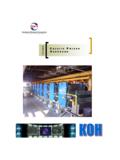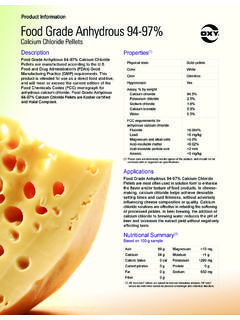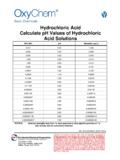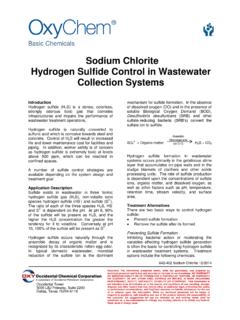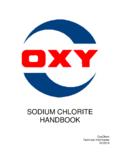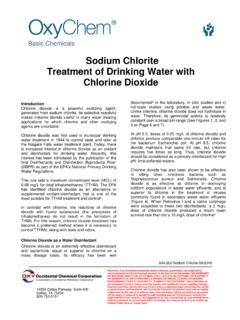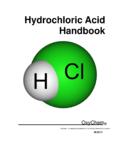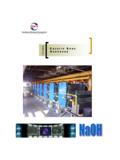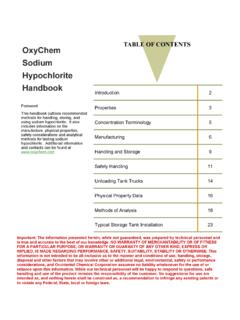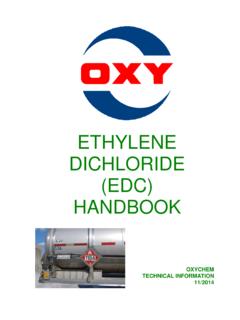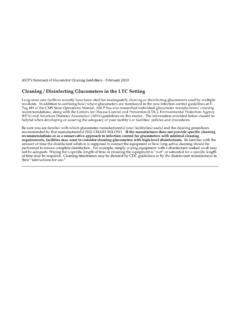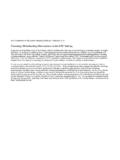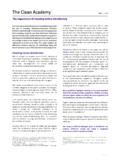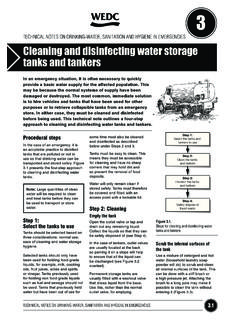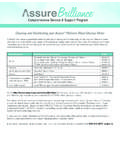Transcription of DISINFECTING COMPOSITIONS FOR POTABLE …
1 DISINFECTING COMPOSITIONSFOR POTABLE WATERW ater treatment professionals want a disinfectant that is safe, effective and easy touse. That is why OxyChem s ACL chlorinated isocyanurates are available for treatmentof POTABLE water. ACL products are available as both quick-dissolving granules andlong-lasting tablets that offer superior Chlorine AdvantageChlorine is the best overall disinfectant,germicide, algaecide and anti-slime agentavailable. Numerous laboratory tests andyears of use have proven that no otherdisinfectant can match chlorine s performancein all of these areas.
2 For more than a century,chlorine has been the choice for watertreatment, especially drinking water. Over98% of all municipal water treatment facilitiesin the United States currently use the source of chlorine is elementalchlorine, sodium hypochlorite (bleach),calcium hypochlorite, or chlorinatedisocyanurates (ACL products), all liberate freechlorine when dissolved in water. In solution,free chlorine exists as hypochlorous acid(HOCl), a chemicalwith excellent sanitizing andoxidizing properties. Free chlorine readily killsbacteria, algae, fungi and viruses. It alsooxidizes and eliminates organic contaminantsand converts some soluble metallic impuritiesinto insoluble solids that can be easilyremoved by is ACL?
3 ACL is OxyChem s trade name for a family ofchlorinated isocyanurates. These products aredry, highly concentrated chlorine-containingsolids that have been used in swimming poolssince the 1960s. OxyChem s chlorinatedisocyanurates are approved by the Protection Agency (EPA) forroutine use in POTABLE water and certifiedunder NSF/ANSI Standard 60 (DrinkingWater Treatment Chemicals Health Effects)for use as drinking water markets four solid products forpotable water chlorination: ACL 90 DISINFECTING Tablets plus ACL 90, ACL 60 andACL 56 DISINFECTING Granules. Each numberin the product name reflects the approximateavailable chlorine content in that example, ACL 90 contains about 90%available , the world s largest producer ofchlorinated isocyanurates, manufactures theseproducts in ISO 9001:2008 certified plants atSauget, IL and Luling, LA.
4 We are a provenleader in the industry, with over 50 years ofexperience in the manufacture and use ofchlorinated 90 The chemical name for ACL 90 istrichloroisocyanuric acid or trichlor forshort. ACL 90 has the highest availablechlorine content (90%) of any solid is available in one inch (14 gram) or threeinch (200 gram) tablets that dissolve over aperiod of time forsustained release. Used in anautomatic feeder, ACL 90 tablets provide acontinuous supply of chlorineto the waterstream, making them especially suitable forcontinuous feed 90 is also available as a granular solidthat can be fed on either a continuous orintermittent basis with a granular feeders are particularly suitable forlarger applications.
5 Tablet feeders are usuallythe choice for smaller applications (less than50 pounds of product per day).ACL 56 and ACL 60 ACL 56 and ACL 60 are sodium salts ofdichloroisocyanuric acid or dichlor forshort. ACL 56 is a dihydrate with an availablechlorine content of 56%. ACL 60 is ananhydrous material with an available chlorinecontent of 63%.Both ACL 56 and ACL 60 are quick dissolvinggranular solids with high solubility in dissolve completely and five times fasterthan calcium hypochlorite. They are ideal forsingle dose or intermittent feed applicationsand also can be used for continuouschlorination with a granular 56 and ACL 60 both have an essentiallyneutral pH.
6 As a result, they have little effecton the treated water s pH and hypochlorite and bleach are highlyalkaline and may require a pH adjustmentwith and PackagingACL products are white, crystalline solids thathave excellent stability under proper storageconditions. Unlike sodium hypochloritebleach, ACL DISINFECTING Tablets andGranules maintain their chlorine contentalmost indefinitely. OxyChem s line of ACLproducts is available in a wide range ofpackage sizes. ACL 90, ACL 56 and ACL 60 DISINFECTING Granules are most commonlysold in 50 lb. pails, while ACL 90 DisinfectingTablets are typically sold in 55 lb.
7 And EfficacyChlorinated isocyanurates liberate cyanuricacid when dissolved in water. Cyanuric acidis an effective chlorine stabilizer in swimmingpools. In POTABLE water, it is simply a carrierfor the available chlorine, allowing it to existin a solid, stable, dry and safe-to-handle studies of cyanuric acid over thepast 40 years have supported OxyChem sACL product registrations with EPA andshown that it is nontoxic. Cyanuric acid is notmetabolized in the body. When ingested, itpasses unchanged in the urine. Cyanuric acidis not fetotoxic (toxic to fetuses), teratogenic(causing birth defects), mutagenic (causingcell mutations) or carcinogenic and does notbioaccumulate.
8 Despite their similarity innames, cyanuric has NO relation to is neither made from nor will it formcyanide during part of the extensive review process forapproving OxyChem s ACL products for usein POTABLE water, EPA examined both toxicityand efficacy. Based on a comprehensivedatabase for the chlorinated isocyanurates andcyanuric acid, EPA concluded thatOxyChem s ACL products are safe andeffective for use in treating POTABLE full text of the approved labels for theseproducts are available at EPA s website: :1 Refer to registration numbers 935-40 (for ACL90 tablets), 935-41 (for ACL 60), 935-39 (forACL 90 granules) and 935-42 (for ACL 56).
9 ACL DISINFECTING Tablets and Granules alsoare certified by NSF International underStandard 60 (Drinking Water TreatmentChemicals Health Effects) for use asdrinking water additives. NSF certification isnormally a requirement for use in municipalwater systems. For more information, refer toNSF International s website at: of Chlorine ProductsSafety and HandlingElemental chlorine(in the liquid state) is arelatively inexpensive and stable source ofavailable chlorine. Like other hazardouschemicals, elemental chlorine can have seriousconsequences if mishandled. Numerousrestrictions and regulations apply to ensurethe safe handling of elemental chlorine, andthese can add significantly to its overall a result, many municipalities now aresearching for effective alternatives for theirwater treatment hypochloritesolution (bleach) is lesshazardous than elemental chlorine, but isdifficult to handle and has a limited storagelife.
10 Spills are hazardous and can be difficultto contain. The available chlorine content ofbleach is 15% or less. Added costs forequipment and shipping large amounts ofsuch a dilute product can add significantly toits overall disinfectants such as the ACL productshave a safety advantage over gaseous andliquid materials since spills or leaks are mucheasier to contain and clean hypochloritecontributes to scalingor cloudiness in the treated water and canproduce calcium sludge in the feeder. It canalso be a fire hazard and is classified as aClass 3 Oxidizer by the National FireProtection Association (NFPA)1.
